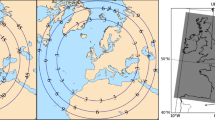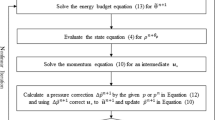Abstract
The spectral method is generally assumed to provide better numerical accuracy than the finite difference method. However, the majority of regional models use finite discretization methods due to the difficulty of specifying time-dependent lateral boundary conditions in spectral models. This study evaluates the behavior of nonhydrostatic dynamics with a spectral discretization. To this end, Juang’s nonhydrostatic dynamical core for the National Centers for Environmental Prediction (NCEP) regional spectral model has been implemented into the Regional Model Program (RMP) of the Global/Regional Integrated Model system (GRIMs). The behavior of the nonhydrostatic RMP is validated, and compared with that of the hydrostatic core in 2-D idealized experiments: the mountain wave, rising thermal bubble, and density current experiments. The nonhydrostatic effect in the RMP is further validated in comparison with the results from the Weather Research and Forecasting (WRF) model, which uses a finite difference method. The analyses of the experimental results from the RMP generally follow the characteristics found in previous studies without any discernible difference. For example, in both the RMP and the WRF model, the eastward-tilted propagation of mountain waves is very similar in the nonhydrostatic core experiments. Both nonhydrostatic models also efficiently reproduce the motion and deformation of the warm and cold bubbles, but the RMP results contain more small-scale noise. In a 1-km real-case simulation testbed, the lee waves that originate over the eastern flank of the Korean peninsula travel further eastward in the WRF model than in the RMP. It is found that differences of small-scale wave characteristics between the RMP and WRF model are mainly from the numerical techniques used, such as the accuracy of the advection scheme and the magnitude of the numerical diffusion, rather than from discrepancies in the spatial discretization.











Similar content being viewed by others
References
Ahmad N, Lindeman J (2007) Euler solutions using flux-based wave decomposition. Int J Numer Methods Fluids 54:47–72
Bubnová R, Hello G, Bénard P, Geleyn JF (1995) Integration of the fully elastic equations cast in the hydrostatic pressure terrain-following coordinate in the framework of the ARPEGE/Aladin NWP system. Mon Weather Rev 123:515–535
Chen F, Dudhia J (2001) Coupling an advanced land surface—hydrology model with the Penn State—NCAR MM5 modeling system. Part I: Model implementation and sensitivity. Mon Weather Rev 129:569–585
Chou MD, Suarez MJ (1994) An efficient thermal infrared radiation parameterization for use in general circulation models. NASA Tech Memo NASA/TM 104606 3:85
Chou MD, Suarez MJ (1999) A solar radiation parameterization for atmospheric studies. NASA Tech Memo NASA/TM 104606 15:38
Cocke S (1998) Case study of Erin using the FSU nested regional spectral model. Mon Weather Rev 126:1337–1346
Davies HC, Turner RE (1977) Updating prediction models by dynamical relaxation: an examination of the technique. Quart J R Meteorol Soc 103:225–245
Doyle JD, Durran DR, Chen C, Colle BA, Georgelin M, Grubisic V, Hsu WR, Huang CY, Landau D, Lin YL, Poulus GS, Sun WY, Weber DB, Wurtele MG, Xue M (2000) An intercomparison of model-predicted wave breaking for the 11 January 1972 Boulder windstorm. Mon Weather Rev 128:901–914
Doyle JD, Gaberšek S, Jiang Q, Bernardet L, Brown JM, Dörnbrack A, Filaus E, Grubišić V, Kirshbaum DJ, Knoth O, Koch S, Schmidli J, Stiperski I, Vosper S, Zhong S (2011) An Intercomparison of T-REX mountain wave simulations and implications for mesoscale predictability. Mon Weather Rev 139:2811–2831
Dudhia J (1993) A nonhydrostatic version of the Penn State–NCAR Mesoscale Model: validation tests and simulation of an Atlantic cyclone and cold front. Mon Weather Rev 121:1493–1513
Dudhia J (2014) A history of mesoscale model development. Asia Pac J Atmos Sci 50:121–131
Durran DR, Klemp JB (1983) A compressible model for the simulation of moist mountain waves. Mon Weather Rev 111:2341–2361
Ek MB et al (2003) Implementation of Noah land surface model advances in the National Centers for Environmental Prediction operational mesoscale Eta model. J Geophys Res 108:8851
Girard C, Jarraud M (1982) Short and medium range forecast differences between a spectral and grid point model. An extensive quasi-operational comparison. ECMWF Tech Rep 32:178
Han J, Juang H-MH (2005) NCEP RSM system. In: 6th international RSM workshop, IRI, New York
Haugen JE, Machenhauer B (1993) A spectral limited-area model formulation with time dependent boundary conditions applied to the shallow-water equations. Mon Weather Rev 121:2618–2630
Hong S-Y, Chang E-C (2012) Spectral nudging sensitivity experiments in a regional climate model. Asia Pac J Atmos Sci 48:345–355
Hong S-Y, Kanamitsu M (2014) Dynamical downscaling: fundamental issues from an NWP point of view and recommendations. Asia Pac J Atmos Sci 50:83–104
Hong S-Y, Dudhia J, Chen S-H (2004) A revised approach to ice microphysical processes for the bulk parameterization of clouds and precipitation. Mon Weather Rev 132:103–120
Hong S-Y, Noh Y, Dudhia J (2006) A new vertical diffusion package with an explicit treatment of entrainment processes. Mon Weather Rev 134:2318–2341
Hong S-Y, Jang J, Lee J (2013a) The GRIMs shallow convection scheme. In: 14th annual WRF user’s workshop. NCAR, Boulder
Hong S-Y, Park H, Cheong H-B, Kim J-E, Koo M-S, Jang J, Ham S, Hwang S-O, Park B-K, Chang E-C, Li H (2013b) The global/regional integrated model system (GRIMs). Asia Pac J Atmos Sci 49:219–243. doi:10.1007/s13143-013-0023-0
Hsu W-R, Sun W-Y (2001) A time-split, forward-backward numerical model for solving a nonhydrostatic and compressible system of equations. Tellus 53A:279–299
Jablonowski C, Williamson DL (2011) The pros and cons of diffusion, filters and fixers in atmospheric general circulation models. Numerical techniques for global atmospheric models. In: Lauritzen PH et al (eds) Lecture notes in computational science and engineering, vol 80. Springer, Berlin, pp 389–504
Jang W, Chun H-Y (2010) A numerical study on severe downslope windstorms occurred on 5 April 2005 at Gangneung and Yangyang, Korea. Asia Pac J Atmos Sci 46:155–172
Janjic ZI, Gerrity JP Jr, Nickovic S (2001) An alternative approach to nonhydrostatic modeling. Mon Weather Rev 129:1164–1178
Jarraud M, Girard C, Cubasch U (1981) Comparison of medium range forecasts made with models using spectral or finite difference techniques in the horizontal. ECMWF Tech Rep 23:96
Juang H-MH (1992) A spectral fully compressible nonhydrostatic mesoscale model in hydrostatic sigma coordinates: formulation and preliminary results. Meteorol Atmos Phys 50:75–88
Juang H-MH (2000) The NCEP mesoscale spectral model: a revised version of the nonhydrostatic regional spectral model. Mon Weather Rev 128:2329–2362
Juang H-MH, Kanamitsu M (1994) The NMC nested regional spectral model. Mon Weather Rev 122:3–26
Juang H-MH, Hong S-Y, Kanamitsu M (1997) The NCEP regional spectral model: an update. Bull Am Meteorol Soc 78:2125–2143
Kain JS (2004) The Kain-Fritsch convective parameterization: an update. J Appl Meteorol 43:170–181
Klemp JB, Lilly DK (1975) The dynamics of wave-induced downslope winds. J Atmos Sci 32:320–339
Klemp JB, Lilly DK (1978) Numerical simulation of hydrostatic mountain waves. J Atmos Sci 35:78–107
Klemp JB, Skamarock WC, Dudhia J (2007) Conservative split-explicit time integration methods for the compressible nonhydrostatic equations. Mon Weather Rev 135:2897–2913
Klemp JB, Dudhia J, Hassiotis AD (2008) An upper gravity-wave absorbing layer for NWP applications. Mon Weather Rev 136:3987–4004
Laprise R (1992) The Euler equations of motion with hydrostatic pressure as an independent variable. Mon Weather Rev 120:197–207
Lu F-C, Liao C-C, Juang H-MH (2007) Revisiting horizontal diffusion of perturbations over terrain for NCEP RSM. Terr Atmos Ocean Sci 18:67–83
Peltier WR, Clark TL (1979) The evolution and stability of finite-amplitude mountain waves. Part II: Surface wave drag and severe downslope windstorms. J Atmos Sci 36:1498–1529
Skamarock WC, Klemp JB (2008) A time-split nonhydrostatic atmospheric model for weather research and forecasting applications. J Comput Phys 227:3465–3485
Skamarock WC, Klemp JB, Dudhia J, Gill DO, Barker DM, Duda MG, Huang XY, Wang W, Powers JG (2008) A description of the advanced research WRF version 3: NCAR/TN-475 + STR, NCAR technical note. NCAR, Boulder, p 88
Smith RB (1985) On severe downslope winds. J Atmos Sci 42:2597–2603
Straka JM, Wilhelmson RB, Wicker LJ, Anderson JR, Droegemeier KK (1993) Numerical solutions of a nonlinear density current: a benchmark solution and comparison. Int J Numer Methods Fluids 17:1–22
Tatsumi Y (1986) A spectral limited-area model with time dependent lateral boundary conditions and its application to a multi-level primitive equation model. J Meteorol Soc Japan 64:637–663
Wicker LJ, Skamarock WC (1998) A time-splitting scheme for the elastic equations incorporating second-order Runge-Kutta time differencing. Mon Weather Rev 126:1992–1999
Acknowledgments
The authors thank Eun-Chul Chang, Jongil Han, and Hann-Ming Henry Juang for their work and comments during the early stage of implementation of the nonhydrostatic core into the RMP. We also acknowledge Suk-Jin Choi for his comments on our study, and we are grateful to the anonymous reviewers for their valuable comments to improve the quality of this paper. This work was partly carried out through the R&D project on the development of global numerical weather prediction systems of the Korea Institute of Atmospheric Prediction Systems (KIAPS), funded by the Korea Meteorological Administration (KMA).
Author information
Authors and Affiliations
Corresponding author
Additional information
Communicated by J.-F. Miao.
Rights and permissions
About this article
Cite this article
Jang, J., Hong, SY. Comparison of nonhydrostatic and hydrostatic dynamical cores in two regional models using the spectral and finite difference methods: dry atmosphere simulation. Meteorol Atmos Phys 128, 229–245 (2016). https://doi.org/10.1007/s00703-015-0412-2
Received:
Accepted:
Published:
Issue Date:
DOI: https://doi.org/10.1007/s00703-015-0412-2




